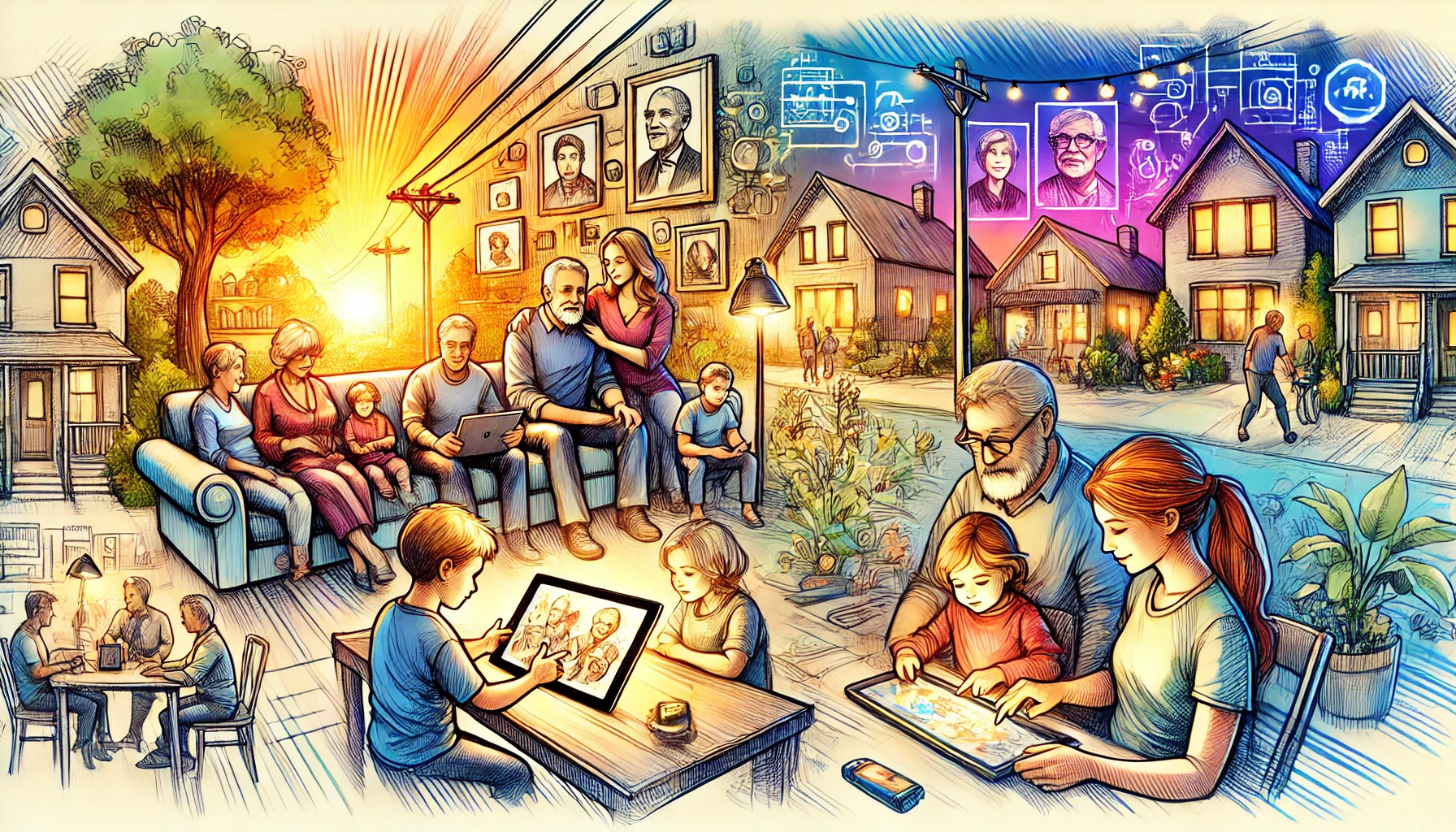Technology has dramatically transformed how we communicate, interact, and share information, impacting all aspects of life, including intergenerational relationships. While technology can sometimes create a divide between generations, it also offers numerous opportunities to bridge gaps, foster connections, and enhance understanding. By leveraging technology thoughtfully and inclusively, families can strengthen bonds across generations. Here are key ways technology impacts intergenerational relationships, along with strategies to maximize its benefits.
1. Enhancing Communication
- Video Calls: Tools like Zoom, Skype, and FaceTime allow family members to see and talk to each other in real-time, bridging physical distances.
- Messaging Apps: Apps like WhatsApp, Facebook Messenger, and iMessage facilitate instant communication, keeping everyone connected.
- Social Media: Platforms such as Facebook, Instagram, and Twitter enable sharing updates, photos, and life events, helping family members stay informed about each other’s lives.
- Regular digital communication helps maintain strong relationships, even when family members are geographically separated.
2. Sharing Memories and Stories
- Digital Photo Albums: Platforms like Google Photos, Shutterfly, and iCloud allow families to create and share digital photo albums.
- Video Sharing: YouTube, Vimeo, and family-specific platforms like VidHug let families share videos of special moments and everyday life.
- Storytelling Apps: Apps like StoryCorps and FamilySearch Memories encourage recording and sharing family stories and oral histories.
- Sharing memories and stories through technology preserves family history and fosters a sense of continuity and connection.
3. Learning and Teaching Opportunities
- Online Learning: Websites like Coursera, Khan Academy, and YouTube offer educational content that family members can explore together.
- Skill Sharing: Younger family members can teach older relatives how to use new technologies, while older generations can share their knowledge and skills in various fields.
- Virtual Classes and Workshops: Participating in online classes or webinars together promotes lifelong learning and mutual respect.
- Engaging in educational activities together bridges generational gaps and promotes mutual appreciation of knowledge and skills.
4. Fostering Collaboration
- Family Projects: Collaborative tools like Google Docs, Trello, and shared calendars help family members work together on projects, plan events, and organize activities.
- Creative Platforms: Websites like Pinterest and Canva enable families to collaborate on creative projects, from home decor to digital scrapbooking.
- Gaming: Online multiplayer games and virtual reality experiences can be enjoyed by different generations, promoting teamwork and fun.
- Collaborative projects and activities strengthen family bonds through shared goals and achievements.
5. Staying Informed and Connected
- News Aggregators: Apps like Flipboard, Feedly, and Google News keep family members updated on current events, providing common topics for discussion.
- Health and Fitness Apps: Apps like MyFitnessPal, Fitbit, and Headspace support family members in staying healthy and can be used to set and achieve fitness goals together.
- Virtual Gatherings: Platforms like Zoom and Houseparty enable virtual family reunions, game nights, and holiday celebrations, ensuring that family traditions continue despite physical distances.
- Staying informed and engaged with each other’s interests and activities fosters a supportive and connected family environment.
6. Overcoming Barriers to Interaction
- Accessibility Tools: Technologies like voice-to-text, screen readers, and adjustable text sizes make digital communication more accessible for older family members.
- Simplified Devices: Devices designed for seniors, such as GrandPad or Jitterbug phones, offer user-friendly interfaces that make technology less intimidating.
- Tech Support: Encouraging younger family members to assist older relatives with technology helps bridge the digital divide and enhances relationships.
- Overcoming technological barriers ensures that all family members can participate in digital communication and activities.
7. Preserving Family History
- Genealogy Websites: Platforms like Ancestry.com and MyHeritage allow families to research and document their ancestry, creating a shared family tree.
- Digital Archives: Creating digital archives of family documents, photos, and videos preserves important memories and history for future generations.
- Storytelling Apps: Tools like StoryWorth send weekly prompts for relatives to write their memories, which can be compiled into a family memoir.
- Preserving family history through technology ensures that the legacy and stories of older generations are passed down and celebrated.
8. Promoting Empathy and Understanding
- Virtual Reality (VR): VR experiences can simulate different life experiences and historical events, fostering empathy and understanding between generations.
- Cultural Exchange: Online platforms that share cultural and historical content can help family members appreciate diverse perspectives and backgrounds.
- Digital Storytelling: Creating and sharing digital stories or blogs about personal experiences promotes empathy and deepens family connections.
- Promoting empathy and understanding through technology enhances relationships by encouraging appreciation of diverse experiences.
9. Encouraging Fun and Entertainment
- Streaming Services: Platforms like Netflix, Disney+, and Hulu offer a wide range of movies and shows that families can watch together.
- Music Apps: Spotify, Apple Music, and YouTube Music allow family members to share playlists and discover new music together.
- Online Games: Multiplayer games and apps like Jackbox Games, Among Us, and Minecraft provide fun, interactive experiences for all ages.
- Sharing entertainment and fun activities strengthens bonds and creates joyful family moments.
10. Addressing Challenges and Limitations
- Digital Detox: Encouraging regular breaks from technology to engage in face-to-face interactions and outdoor activities.
- Cybersecurity Education: Teaching all family members about online safety, privacy, and responsible digital behavior.
- Balancing Screen Time: Setting guidelines to ensure technology enhances rather than detracts from family relationships.
- Addressing challenges and limitations ensures that technology use is healthy and beneficial for family dynamics.
Technology profoundly impacts intergenerational relationships by enhancing communication, sharing memories, fostering learning, and promoting collaboration. By leveraging digital tools and platforms, families can stay connected, celebrate their history, and engage in meaningful activities together. Addressing the challenges of technology use, such as digital literacy and screen time balance, is crucial for maximizing its positive impact on family bonds. Embracing technology thoughtfully and inclusively strengthens intergenerational relationships, creating a supportive and connected family environment.

